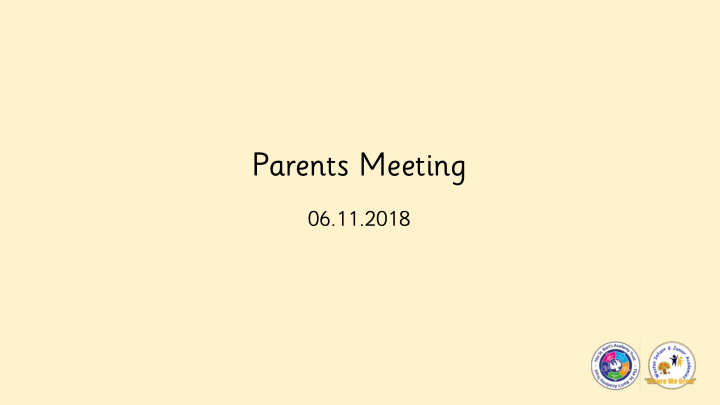



Parents Meeting 06.11.2018
Welcome… • There are no fire drills planned • Please feel free to ask questions at any time • If your question is specifically about your child’s progress, please save it for the end and we will happily discuss it 1-1 with you • All of the resources, examples and links to ideas are available on the school website for you to view
What we expect from a Year 1 piece of writing… • A few sentences which are linked • Finger spaces between words Capital letters and full stops to be used some of the time • • Using ‘and’ and ‘because’ to extend writing Use adjectives to describe • • Spell common year 1 words correctly • Use the past and present tense correctly most of the time Most letters formed in the correct direction starting and ending • in the correct place • Beginning to use ? and ! correctly
Full stops and capital letters are mostly correct. Fingers spaces are clear. ‘because’ and ‘and’ used correctly. Adjectives used to describe. Common Y1 words mostly spelt correctly. Next Steps - suffixes
What we expect from Year 2 writing… The pupil can, after discussion with the teacher: • write simple, coherent narratives about personal experiences and those of others • write about real events, recording these simply and clearly • demarcate most sentences in their writing with capital letters and full stops, and use question marks correctly when required • use present and past tense mostly correctly and consistently • use co-ordination (e.g. or / and / but) and some subordination (e.g. when / if / that / because) to join clauses • segment spoken words into phonemes and represent these by graphemes, spelling many of these words correctly and making phonically-plausible attempts at others • spell many common exception words • form capital letters and digits of the correct size, orientation and relationship to one another and to lower-case letters • use spacing between words that reflects the size of the letters.
Capitals and full stops most of the time . Letter sizing. Subordination and Co-ordination. Consistent use of tense . Spelling common exception words.
What we expect from a Year 1 as a reader… • Reading fluently at Orange band or higher. • Able to answer a range of comprehension questions about what they have read. • Able to read their own work back. Formal Assessment… Children are assessed using ‘Phonics Screening’ •
What we expect from a Year 2 as a reader… Reading fluently, at around White Band • • Able to answer a range of comprehension questions, as well as inference questions • Reading with expression and intonation • Strong plot recall Formal assessment… • Reading SATs – More on this later
What we expect from a Year 1 in Mathematics… Able to count forwards and backwards beyond 100 • • Able to count in 2s 5s and 10s To be secure with number bonds within 10 • • Able to solve simple multiplication and division problems • Able to add and subtract 1 and 2 digit numbers within 100 Able to identify 1 more and 1 less than a number • • Understand what half and quarter mean Recognise and name basic 2D and 3D shapes • • Solve practical problems involving mass/weight, height/length, capacity/volume and time.
What we expect from a Year 2 in Mathematics… • To know the 2s, 5s, 10s and 3s times tables – out of order • To be secure with number bonds within 20 • Able to solve more complex multiplication and division problems • Able to add and subtract 2 digit numbers up to and over 100 Able to combine money to make an amount • Understand what half and quarter and three quarters mean • • Recognise and name 2d and 3d shapes • To describe the properties of these • To sort shapes using different criteria Solve numerical problems involving mass/weight, height/length, • capacity/volume • To know the time to the nearest five minutes • To apply all of this knowledge in a 2 step problem
Common mistakes… Year 1 Year 2 b / d reversal Missing words when speaking Missing words when speaking Letter formation Finger spaces between words Homophones Knowing where to put full stops Telling the time
How we support your children… • Support plans • QFT • Extra support in lessons • Immediate 1-1 or small group support • Extra resources
How you can help… • Read at least 3 times per week (don’t forget to sign in the reading record) • Complete the spellings sent home by your child’s teacher • Support your child in completing their homework • Find opportunities for learning – in the car, walking to school etc. Examples: Counting steps (in 1s, 2s, 5s, 10s etc.) Giving real life opportunities to add and take away Baking – opportunities to measure Reading – signs, shop names, menus, instructions etc.
SATs • Compulsory • 4 papers overall • Conducted throughout May • Small groups • 2 familiar adults • Practise questions • Children are familiar with the format
Working at What scores you will get… Greater Depth within the Expected Standard • Results come out on your child’s Working at the ‘End of Year Report’ Expected Standard • They will be displayed as shown • Raw score – Scaled score – Pass Working Towards the Mark Expected Standard Working Below the National Standard
Useful websites… https://www.phonicsplay.co.uk/ https://www.oxfordowl.co.uk/ https://www.topmarks.co.uk/maths-games/hit-the-button http://www.snappymaths.com/ http://www.ictgames.com/ http://www.purplemash.co.uk/ https://www.gov.uk/education/phonics
Thank you for coming… Any questions?
Recommend
More recommend